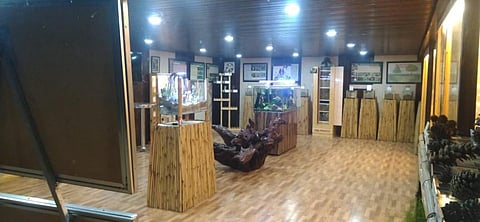

DEHRADUN: Uttarakhand’s first biodiversity gallery was inaugurated on Sunday in Haldwani of Nainital district.
Established by funding from Japanese International Cooperation Agency (JAICA), the gallery showcases lesser known aspects of rich bio-diversity of the hill state.
Sanjiv Chaturvedi, chief conservator of forests (Research), who heads the research wing of the department told TNIE, "Uttarakhand, having a unique position, with all the three agro climatic zones – tropical, temperate, alpine and also being at the confluence of Western Himalaya and Eastern Himalayas has an extremely rich bio diversity in all types of flora and fauna."
However, only a few species out of this rich depository, are currently known in public domain and this bio diversity gallery is an attempt to plug that gap, added the officials.
The main feature of this biodiversity gallery is depiction of 101 icons of state's biodiversity showing threat status, and information about habitat and ecological role/uses, about 101 peculiar species of flora and fauna, native to the hill state.
It includes largest lily of world found in State (Giant Himalayan Lily), largest species of Rhododendron in world (Rhododendron Arboreum), largest venomous snake of world (King Cobra), highest altitude venomous snake (Himalayan Pit Viper), largest honeybee of world (Giant Himalayan Honey Bee), largest moth of world (Atlas moth), largest marten of world (Yellow throated marten), largest insectivorous bat of India (Great Himalayan Leaf nosed bat) as well as other interesting species, naturally found in Uttarakhand.
Salty headed parakeet (only species of parakeet family which migrates in winter), Himalayan langur (only primate species found in Himalayas) and also interesting species of native insectivorous plants, fern, moss, liverwort, grass species and peculiar fauna like Himalayan Marmot (highest elevation dwelling mammal of world - found at Tibet border), Himalayan Pika, flying squirrel and Yellow headed tortoise.
Apart from 101 'Biodiversity Icons', there are 8 other sections – one section displays abandoned nests of various species like Weaver bird, King cobra (only reptile species which makes nests).
Another section displays unique biodiversity products of State - Keedajadi (world’s costliest fungus), red honey (produced by giant honey bee and one of the costliest honey in the world), and bio diversity products of the State which have been given Geographical Indicator (GI) tag – like butter from Cheura Tree and Ringal handicraft.
There is also a section displaying soil diversity of the state showcasing all the eight types of soil found in Uttarakhand from Terai/Bhahar Zone to Alpine areas.
A section displaying biodiversity of medicinal herbs including extracts from Ashtavarga and Dashmool species.
Other sections include orchid, moss, and lichen bio-diversity, agricultural bio-diversity of the state with seeds of local crops which have become rare now and also seed of prominent forestry species.
Anup Sah, a Padam Awardee photographer and conservationist who inaugurated the gallery said, "Thi is a noble effort by the officials of the department to showcase uniqueness of the biodiversity of the state. Such efforts are much needed. This is the education which we need to impart to our future generations."